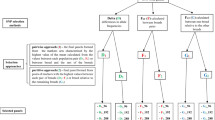Abstract
Human chromosome specific libraries (CSLs) were individually applied to equine metaphase chromosomes using the fluorescencein situ hybridization (FISH) technique. All CSLs, except Y, showed painting signals on one or several horse chromosomes. In total 43 conserved chromosoma segments were painted. Homoeology could not, however, be detected for some segments of the equine genome. This is most likely related to the very weak signals displayed by some libraries, rather than to the absence of similarity with the human genome. In spite of divergence from the human genome, dated 70–80 million years ago, a fairly high degree of synteny conservation was observed. In seven cases, whole chromosome synteny was detected between the two species. The comparative painting results agreed completely with the limited gene mapping data available in horses, and also enabled us provisionally to assign one linkage group (U2) and one syntenic group (NP, MPI, IDH2) to specific equine chromosomes. Chromosomal assignments of three other syntenic groups are also proposed. The findings of this study will be of significant use in the expansion of the hitherto poorly developed equine gene map.
Similar content being viewed by others
References
Andersson L, Haley CS, Ellegren Het al. (1994) Genetic mapping of quantitative trait loci for growth and fatness in pigs.Science 263: 1771–1774.
Bailey E, Graves KT, Cothran EGet al. (1995) Synteny-mapping horse microsatellite markers using a heterohybridoma panel.Anim Genet 26: 170–177.
Bowling AT (1992) Genetics of the horse. In: Evans JW, ed.Horse Breeding and Management. Amsterdam: Elsevier, pp 223–226.
Bradley RD, Wichman HA (1994) Rapidly evolving repetitive DNAs in a conservative genome: a test of factors that affect chromosomal evolution.Chrom Res 2: 354–360.
Chowdhary BP, Frönicke L, Gustavsson Iet al. (1996) Chromosome segment homologies detected between the cattle (Bos taurus) and the human karyotypes using ZOO-FISH (in press).
Collins C, Kuo W-L, Segraves Ret al. (1991) Construction and characterization of plasmid libraries enriched in sequences from single human chromosomes.Genomics 11: 997–1006.
Edwards JH (1994) Comparative genome mapping in mammals.Curr Biol 4: 861–867.
Frönicke L, Scherthan H, Gustavsson Iet al. (1996) Comparative chromosome painting demonstrates gross homology between the karyotypes of domestic pig (Sus scrofa) and man (in press).
Georges M, Dietz AB, Mishra Aet al. (1993) Microsatellic mapping of the gene causing weaver disease in cattle will allow the study of an associated quantitative trait locus.Proc Natl Acad Sci USA 90: 1058–1062.
Hayes H (1995) Chromosome painting with human chromosome-specific DNA libraries reveals the extent and distribution of conserved segments in bovine chromosomes.Cytogenet Cell Genet 71: 168–174.
Lundin LG (1993) Evolution of the vertebrate genome as reflected in paralogous chromosomal regions in man and the house mouse. Analytical review.Genomics 16: 1–19.
Lyons LA, Raymond MM, O'Brien SJ (1994) Comparative genomics: the next generation.Anim Biotech 5: 103–111.
MacLennan DH, Duff C, Zorzato Fet al. (1990) Ryanodine receptor gene is a candidate for predisposition to malignant hyperthermia.Nature 343: 559–561.
Morizot DC (1994) Reconstructing the gene map of the vertebrate ancestor.Anim Biotech 5: 113–122.
Oakefull EA, Buckle VJ, Clegg JB (1993) Localization of the horse (Equus caballus) alpha-globin gene complex to chromosome 13 by fluorescence in situ hybridization.Cytogenet Cell Genet 62: 136–138.
O'Brien SJ, Womack JE, Lyons LAet al. (1993) Anchored reference loci for comparative genome mapping in mammals.Nature Genet,3: 103–112.
Ohno S, Becak W, Becak ML (1964) X-autosome ratio and the behaviour pattern of individual X-chromosomes in placental mammals.Chromosoma 15: 14–30.
Rettenberger G, Klett C, Zechner Uet al. (1995a) Visualization of the conservation of synteny between humans and pigs by heterologous chromosomal painting.Genomics 26: 372–378.
Rettenberger G, Klett Ch, Zechner Uet al. (1995b) Zoo-FISH analysis: cat and human karyotypes closely resemble the putative ancestral mammalian karyotype.Chrom Res 3: 479–486.
Richer CL, Power MM, Klunder LRet al. (1990) Standard karyotype of the domestic horse (Equus caballus).Hereditas 112: 289–293.
Rønne M (1992) Putative fragile sites in the horse karyotype.Hereditas 117: 127–136.
Sandberg K, Andersson L (1993) Horse (Equus caballus). In: O'Brien J, ed.Genetic Maps. Cold Spring Harbor, NY: Cold Spring Harbor Laboratory Press, pp 4.276–4.278.
Scherthan H, Cremer T, Arnason Uet al. (1994) Comparative chromosome painting discloses homologous segments in distantly related mammals.Nature Genet 6: 342–347.
Solinas-Toldo S, Lengauer C, Fries R (1995). Comparative genome map of human and cattle.Genomics 27: 489–496.
Stanyon R, Arnold N, Koehler Uetal. (1995). Chromosomal painting shows that ‘marked chromosomes’ in lesser apes and Old World monkeys are not homologous and evolved by convergence.Cytogenet Cell Genet 68: 74–78.
Vooijs M, Yu L-C, Tkachuk Det al. (1993) Libraries for each human chromosome, constructed from sorter-enriched chromosomes by using linker-adaptor PCR.Am J Hum Genet 52: 586–597.
Wienberg J, Stanyon R, Jauch Aet al. (1990) Molecular cytotaxonomy of primates by chromosomal in situ suppression hybridization.Genomics 8: 347–350.
Williams H, Richards CM, Konfortov BAet al. (1993) Synteny mapping in the horse using horse-mouse heterohybridomas.Anim Genet 24: 257–260.
Author information
Authors and Affiliations
Corresponding author
Additional information
accepted for publication by M. Schmid
Rights and permissions
About this article
Cite this article
Raudsepp, T., Frönicke, L., Scherthan, H. et al. Zoo-FISH delineates conserved chromosomal segments in horse and man. Chromosome Res 4, 218–225 (1996). https://doi.org/10.1007/BF02254963
Received:
Revised:
Accepted:
Issue Date:
DOI: https://doi.org/10.1007/BF02254963




